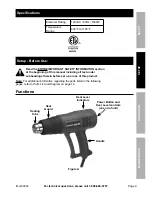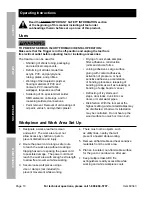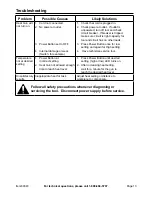
Page 8
For technical questions, please call 1-888-866-5797.
Item 69343
Sa
Fety
Opera
ti
O
n
Maintenance
Setup
extension cords
1�
Grounded
tools require a
three wire extension cord�
Double Insulated
tools can use either
a two or three wire extension cord�
2� As the distance from the supply outlet
increases, you must use a heavier gauge
extension cord� Using extension cords with
inadequately sized wire causes a serious
drop in voltage, resulting in loss of power
and possible tool damage�
(See table a.)
3� The smaller the gauge number of the wire,
the greater the capacity of the cord� For
example, a 14 gauge cord can carry a higher
current than a 16 gauge cord�
(See table a.)
4� When using more than one extension cord
to make up the total length, make sure
each cord contains at least the minimum
wire size required�
(See table a.)
5� If you are using one extension cord for more
than one tool, add the nameplate
amperes
and use the sum to determine the required
minimum cord size�
(See table a.)
6� If you are using an extension cord
outdoors, make sure it is marked with the
suffix “W‑A” (“W” in Canada) to indicate
it is acceptable for outdoor use�
7� Make sure the extension cord is properly
wired and in good electrical condition�
Always replace a damaged extension
cord or have it repaired by a qualified
electrician before using it�
8� Protect the extension cords from
sharp objects, excessive heat,
and damp or wet areas�
table a: recommended Minimum
Wire Gauge for extension cords*
(120/240 Volt)
naMepLate
aMpereS
(at full load)
eXtenSiOn cOrD
LenGtH
25´
50´
75´
100´
150´
0 – 2�0
18
18
18
18
16
2�1 – 3�4
18
18
18
16
14
3�5 – 5�0
18
18
16
14
12
5�1 – 7�0
18
16
14
12
12
7�1 – 12�0
18
14
12
10
‑
12�1 – 16�0
14
12
10
‑
‑
16�1 – 20�0
12
10
‑
‑
‑
* Based on limiting the line voltage drop to
five volts at 150% of the rated amperes.
Symbology
Double Insulated
Canadian Standards Association
Underwriters Laboratories, Inc�
V
Volts
~
Alternating Current
a
Amperes
n0 xxxx/min.
No Load Revolutions
per Minute (RPM)
WARNING marking concerning
Risk of Eye Injury�
Wear ANSI‑approved safety
goggles with side shields�
Read the manual before
set‑up and/or use�
WARNING marking concerning
Risk of Fire�
Do not cover ventilation ducts�
Keep flammable objects away�
WARNING marking concerning
Risk of Electric Shock�
Properly connect power
cord to appropriate outlet�


































